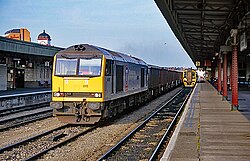 | |
 60015 Bow Fell with Transrail branding, Cardiff, 1996 | |
| Industry | Rail freight |
|---|---|
| Founded | 9 June 1994 as Trainload Freight West |
| Defunct | 1996 |
| Fate | Acquired by Wisconsin Central Ltd. |
| Successor | English Welsh & Scottish |
| Headquarters | , United Kingdom |
| Services | Freight train owner/operator |
| Parent | British Rail |
Transrail was a trainload rail freight operator based in St Blazey, England, UK with a large operating area including Scotland, Wales and the west of England. It was formed in 1994 from part of British Rail's Trainload Freight division, as part of the privatisation of British Rail.
Contents
Mainline Freight, Loadhaul and Transrail were purchased by a consortium led by Wisconsin Central in 1996 and amalgamated into a new company, English Welsh & Scottish.
